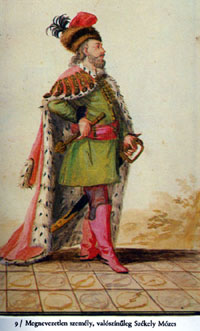Moses Székely facts for kids
Moses Székely (born around 1553 – died July 17, 1603) was a brave military leader who briefly became the Prince of Transylvania in 1603. He was the only ruler from the Székely people to hold this important title.
Moses was a skilled commander who served under Prince Sigismund Báthory. After Sigismund left his rule for the last time in 1601, Transylvania was controlled by soldiers working for the Habsburg general, Giorgio Basta. In April 1603, Moses Székely led the local Transylvanian forces in a rebellion. With help from Turkish and Tartarian (Crimean Khanate) soldiers, he defeated Basta's troops.
On May 8, 1603, Moses Székely became the Prince of Transylvania. However, his rule was short and difficult. His Tartarian soldiers were very cruel, even worse than Basta's troops. Also, Radu Șerban, the new ruler (Voivode) of Wallachia, attacked Transylvania because he was an ally of the Habsburgs.
Sadly, Moses's own people, the Székely, joined the invaders. They fought against Moses, and he was defeated and killed in the Battle of Brașov on July 17, 1603. After this, Radu went back to Wallachia, and Basta's soldiers returned to Transylvania.
Contents
Early Life and Family
Moses Székely was born in a town called Székelyudvarhely (which is now Odorheiu Secuiesc in Romania) around the year 1553. His father, János Literáti Székely, was a nobleman from the Székely people. We don't know much about his mother. Moses had three brothers named István, János, and Péter.
When he was young, Moses worked in the salt trade. He also adopted the Unitarian faith, which was a different kind of Christian belief at the time.
A Brave Warrior's Start
After the ruler John Sigismund passed away, Stephen Báthory was chosen as the new ruler (Voivode) of Transylvania in 1571. Stephen Báthory had an enemy named Gáspár Bekes. In 1575, Bekes invaded Transylvania. Even though Bekes was Unitarian like Moses, Moses Székely chose to support the Catholic Stephen Báthory.
Moses showed incredible bravery during this time. He swam across the Maros River with a sword in his mouth and fought one of Bekes's warriors in a duel, winning the fight. Stephen Báthory noticed his courage and made him the commander of his Székely guards. Moses Székely was the first to lead an attack against Bekes's army in the important Battle of Kerelőszentpál, which Stephen Báthory won on July 8.
Fighting for Poland
In 1575, Stephen Báthory was also chosen to be the ruler of Poland and Lithuania. Moses went with him to Poland. He was a commander of the foot soldiers during the siege of Danzig in 1577. He was injured in his knee during the siege of Polotsk in 1579. He also took part in the siege of Pskov in 1581.
After his time in Poland, Moses returned to Transylvania. Around 1582 or 1583, he was made the head of a salt mine. He also received royal lands in Siménfalva and Lövéte, where he built his manor house. Moses got married in late 1584, but his wife passed away the next year.
Returning Home and New Challenges
In 1594, Moses was sent with a small army to help the Serbs who were rebelling against the Ottoman Empire. However, the Ottomans had already defeated the Serbs by the time Moses arrived. Moses tried to capture a fortress called Facsád, but his cavalry couldn't break in. He was injured during this siege, which left him with a permanent limp for the rest of his life.
In 1595, Moses fought against the Ottomans in Wallachia. He also joined another commander, György Borbély, in an invasion of the Ottoman Empire. Their army captured several fortresses along the Maros River. For a few years after this, Moses didn't seem to be involved in public life.
Transylvania in Turmoil
Transylvania faced a lot of changes in rulers during this period. In 1598, Prince Sigismund Báthory gave up his rule and handed Transylvania over to the Holy Roman Emperor, Rudolph II. Moses Székely began talking with the Emperor's representatives, urging them to send an army to protect Transylvania from the Ottomans.
Moses also secretly worked with Sigismund Báthory's uncle, István Bocskai, to bring Sigismund back to power. When Sigismund returned in August 1598, Moses convinced the Székely warriors to support him. Moses and another commander led an army against a town called Várad, which had refused to accept Sigismund. They also fought off Ottoman and Tatar raiders near the town.
Sigismund Báthory gave up his rule again in 1599, this time to his cousin, Andrew Báthory. However, Emperor Rudolph II convinced Michael the Brave, the ruler of Wallachia, to invade Transylvania. Many Székely commoners joined Michael, who promised them more freedom. Andrew Báthory sent Moses Székely to talk with Michael, but Michael refused to make peace.
Moses was the main commander of Andrew Báthory's army in the Battle of Sellenberk. After the battle was lost, Moses found safety in a fortress. Andrew Báthory tried to escape but was sadly killed by Székely commoners.
Rudolph II then made Michael the Brave his governor in Transylvania. Michael appointed Moses Székely as the supreme commander of the Transylvanian army. Moses joined Michael, and Michael even granted Moses and his son some estates. However, Michael didn't fully trust Moses and often kept him out of important discussions with the Emperor's envoys.
In 1600, Michael the Brave invaded Moldavia, and Moses was one of his commanders. After Michael returned to Transylvania, Moses stayed in Moldavia to command the army there. Later that year, Moses returned to Transylvania and met with other noblemen. They fled to Poland to try and convince Sigismund Báthory to claim Transylvania again.
Family Life
Moses Székely had an elder son named Stephen, who is only mentioned in one document from 1599, suggesting he passed away when he was very young. Moses also had a younger son, who was born after his death, and was also named Moses, known as Moses Székely the Younger.


